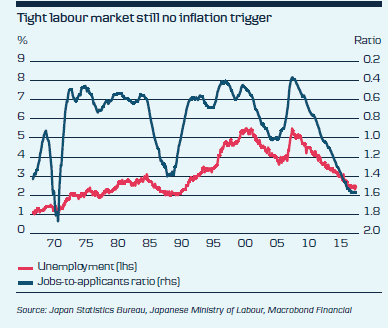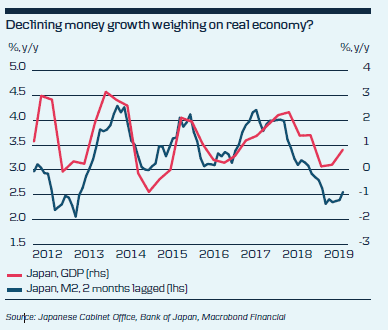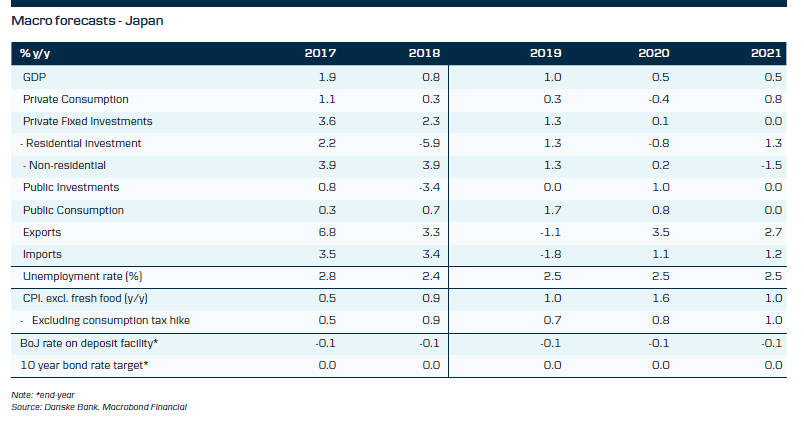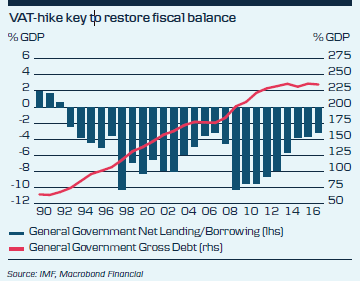- Demand has been slowing in Japan. A record fiscal budget will keep the economy afloat in 2019, along with hoarding effects in the run-up to the VAT hike in October. From 2020 onwards, the economy will have to find support abroad to keep growing. We expect GDP growth of 1.0% in 2019 and 0.5% in 2020 and 2021.
- With a shrinking population, exports are key to growth, even if the Japanese economy is quite closed. A rebound in global growth therefore remains paramount to the outlook.
- The VAT hike poses a risk to domestic demand, although the impact should be much smaller than after previous tax hikes. Future trade negotiations between the US and Japan could also cause some turbulence.
- The inflation outlook still looks modest and we expect the Bank of Japan to remain on hold through 2021.
Weak demand supported by public spending
The underlying strength of the Japanese economy has weakened in 2019. Exporters have struggled with the Chinese slowdown, which has pulled much of the rest of Asia down with it. Declining demand from China and the South East Asian countries, which combined amount for 35% of total exports, has weighed heavy on Japan. This is also reflected in industrial production, as more than half of China’s imports from Japan are machinery and transport equipment.

What started as weakness in the manufacturing sector has spread to domestic demand, where retail sales in particular have declined markedly. On an annual basis, private consumption is still the biggest growth contributor, along with government consumption, even if consumers have remained cautious.
Looking ahead, the basis for a strong pick-up in consumption remains fairly weak. Employment has continued to increase, but despite a historically tight labour market, the spring wage negotiations resulted in only modest wage growth. The uncertain outlook for many Japanese businesses due to the global slowdown and trade war has made companies more reluctant to raise wages than last year and real labour cash earnings declined markedly in Q1. Japanese firms usually prefer to offer one-off bonuses and other benefits instead of raising the base pay. When you have unions with relatively high company loyalty and a strong preference for job security on the other side of the table, wage increases are bound to be modest. If we get the global growth rebound we expect later this year, there could be room for a stronger bonus season around New Year, but a significant pick-up in wages is not in the cards, we believe.

Bumpy road ahead
With an 8-10% VAT hike planned in October, private consumption is in for a bumpy ride, with hoarding effects likely to boost consumption in Q3 before a sharp drop in Q4. The National Diet has approved a record budget, which will provide a significant boost to the economy during Fiscal year 2019, see also box. Another risk is posed by President Donald Trump’s critique of the Japanese trade surplus with the US, the third largest in the world. Japanese cars and US soybeans could end up as key bargaining chips in future Trump-Abe trade negotiations. PM Abe could be forced to break a deal affecting sensitive sectors such as Japanese agriculture and with an upper-house election in July in mind and the US-China trade dispute still unsettled, a US-Japan trade deal does not look to be right around the corner.

Looking beyond the VAT hike and the 2020 Tokyo Olympic games, which is likely to boost demand for a short period, the shrinking population will remain a drag on private consumption and Japan has to look abroad for sustainable growth drivers. Investments have also been boosted by construction spending related to the 2020 Tokyo Olympics. This effect will start to wane next year.
Supported heavily by public spending, we think GDP growth will end up at 1.0% in 2019. 2020 should be more self-driven, but we expect growth to end up at just 0.5%. In 2021, business investments and public support are bound to wane, but the basis for slightly stronger private consumption should be in place. We expect growth to end up at 0.5% in 2021.
Bank of Japan forced to be patient
The share of decreasing items in the inflation basket has declined from 54% to 33% since Haruhiko Kuroda was appointed as the new Bank of Japan (BoJ) Governor back in March 2013. However, this has demanded a tremendous effort. The BoJ has introduced a negative policy rate and guided the 10-year government bond yield below zero. The balance sheet has grown from Y175tr to Y557tr, equivalent to 100% of annual GDP. A strange comparison between stock and flow, but it says something about the magnitude of the BoJ’s QE programme when you compare it to the Fed and the ECB with balance sheets of around 20% and 40% of GDP, respectively.

Slowly the BoJ has realised that reflating the economy will be a long struggle and has taken measures to prolong the durability of the easing policy. Under the current framework with quantitative and qualitative easing and yield curve control, the BoJ ‘only’ needs to grow its balance sheet by Y30tr a year to keep the yield curve in check, making the easing framework much more sustainable. However, it has also induced a decline in broad money growth, (Q1 GDP growth does not reflect the very weak demand), which is likely slowing economic activity and inflation. The issue now is that the most tangible policy measures have already been deployed. The promise at the April meeting to keep rates low until at least spring 2020 was ‘free’ in the sense that it is not likely to demand further stimulus, but the market reaction was also non-existent, probably because no one actually believed the BoJ would engage in any tightening measures before they know the full effects of the October VAT hike.

As we see it, there is not a lot for the BoJ to do currently but hope the global economic recovery regains momentum and continues long enough to kick-start the Philips curve. Despite the tight labour market, there are still very limited signs that inflation is moving much higher. Several supply shocks are set to weigh on inflation over the coming year. A warning from Japan’s biggest mobile phone carrier about significant cuts in mobile subscription charges will pull inflation lower to begin with. After that, free early childhood education and free higher education for low-income families will cause a big decline in inflation. In the short run, this means the outlook for reflating the economy deteriorates for the following year.

We find it difficult to see a scenario where the BoJ can start tightening even in 2021. An ageing population and a declining equity risk premium has pulled the natural rate of interest into negative territory, according to the IMF. That means an interest rate level of -0.1% is barely expansionary as it is. An older population only stands to weigh more heavily on the natural rate of interest in the coming years, and the challenge of low productivity growth does not stand to be fixed any time soon either. If economic activity deteriorates further, a first reaction could be further tweaks to the forward guidance but we do not expect any significant changes to the current policy framework from the BoJ through 2021.

Initial effect of VAT-hike will be cushioned
The VAT tax hike from 8% to 10%, originally planned for 2015, is scheduled for October this year. The Abe government has delayed the hike twice already. One reason for this is that it is unpopular with the public. A poll conducted by the daily Asahi Shimbun in May showed 54% of respondents were against the tax hike. Another reason is the fear of plunging the economy into recession – a legitimate fear considering the 1.8% q/q decline in GDP back in Q2 14, when the tax was increased from 5% to 8%.
This time, a delay is not so likely, although a further deterioration in demand will increase the likelyhood. A new law would have to be enacted, it would be a hassle to rally support in time and the revenue has already been included in the record-high annual budget for fiscal year 2019, featuring increased spending on welfare, public works and defence. Several mitigating measures have been put in place to avoid an incident like 2014. Y2tr of the Y101tr budget are earmarked for fiscal measures, mitigating the VAT hike. Groceries will be excluded from the tax hike and home and car buyers will also experience tax relief. For a limited time, cashless transactions to small and medium retailers will even be subject to a 2% refund and low-income households and those with small children will receive shopping vouchers.
Thus, the tax hike will not restore fiscal balance now, but it is paramount to the plans to achieve a primary budget surplus in the fiscal year 2026.

